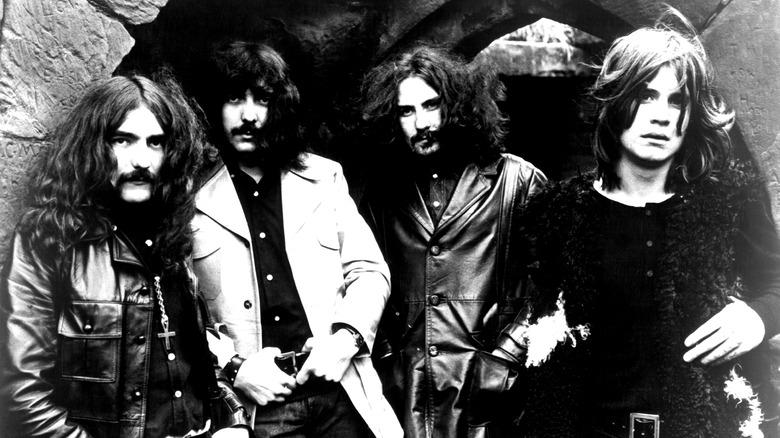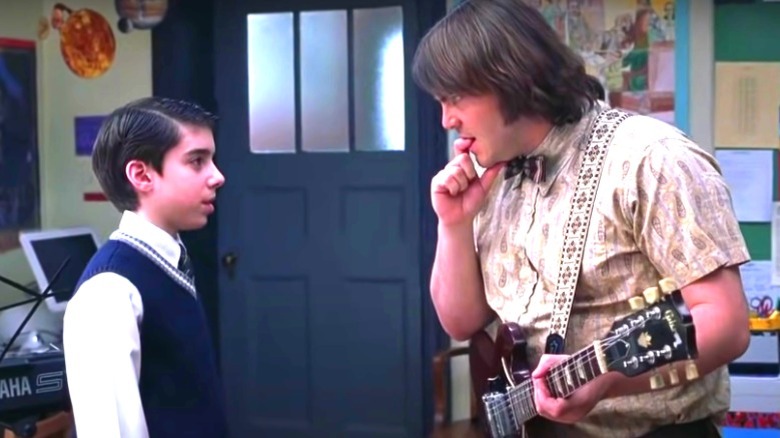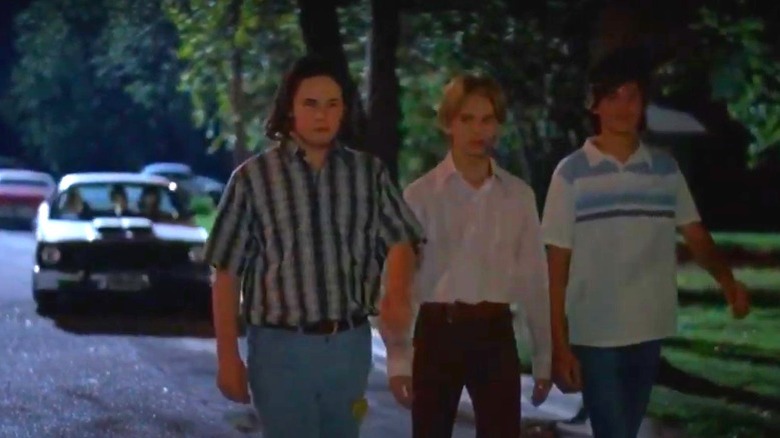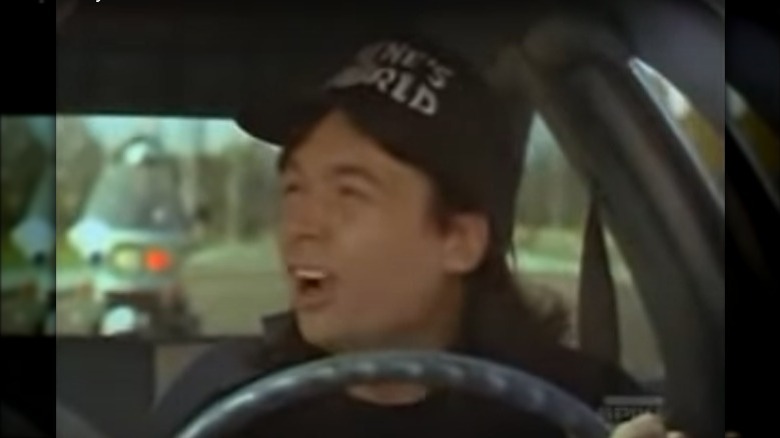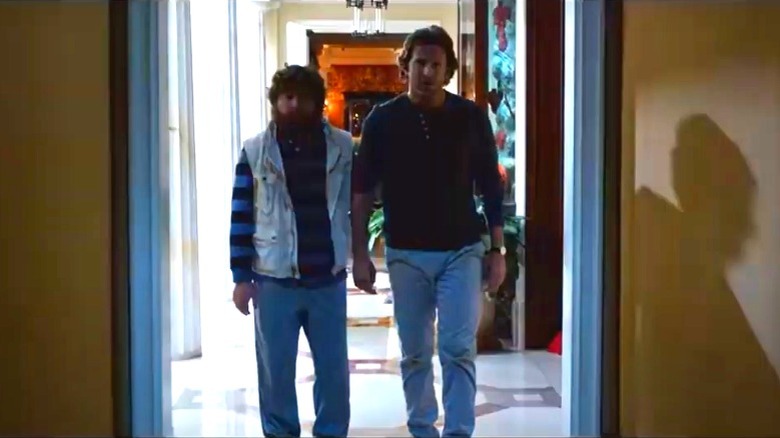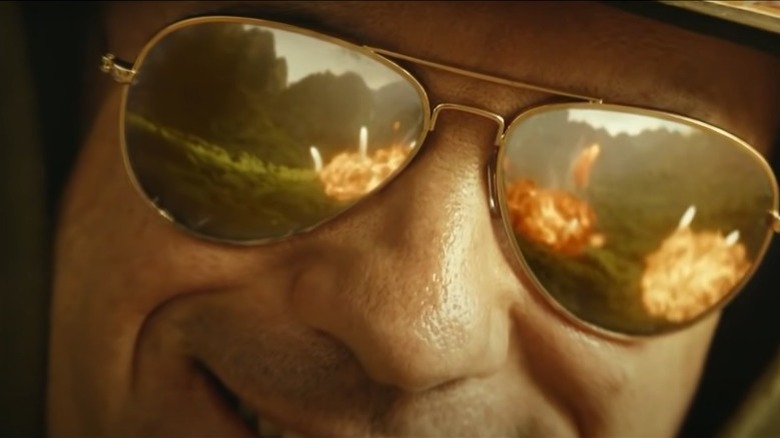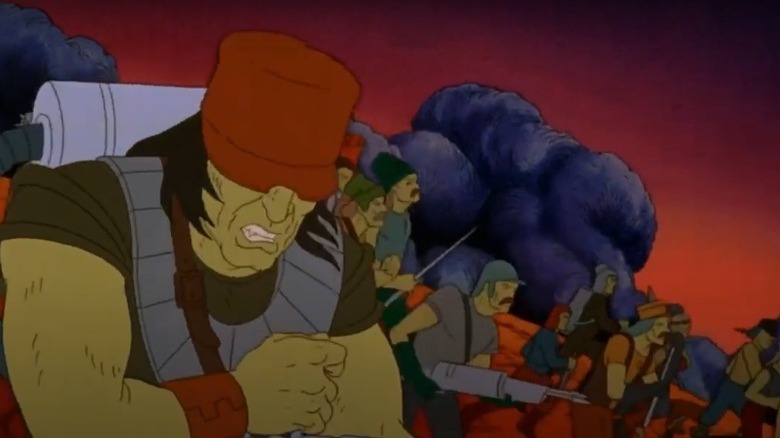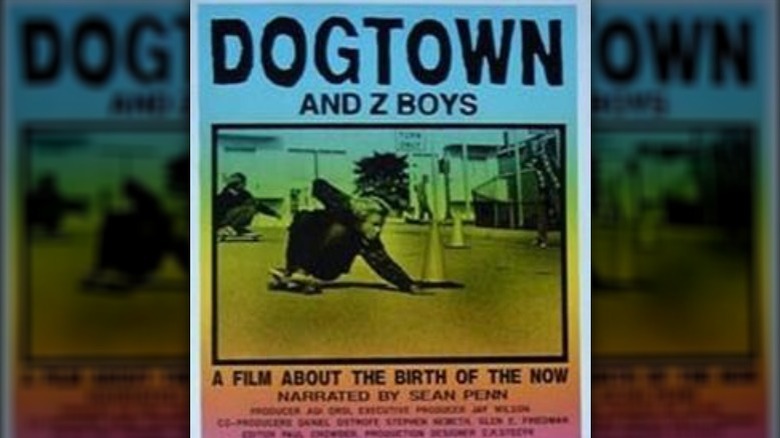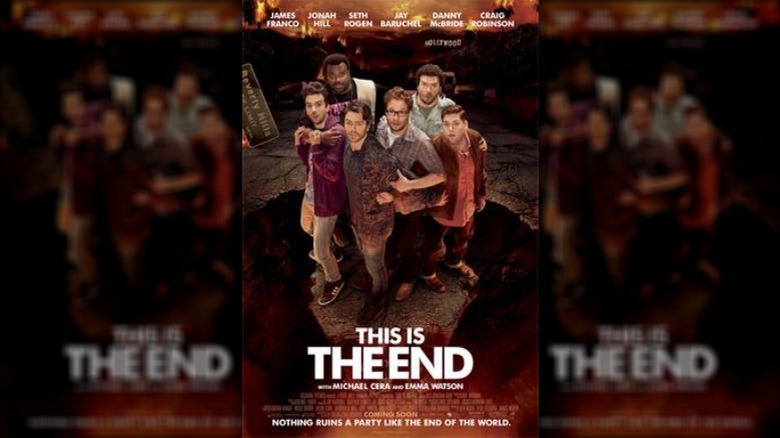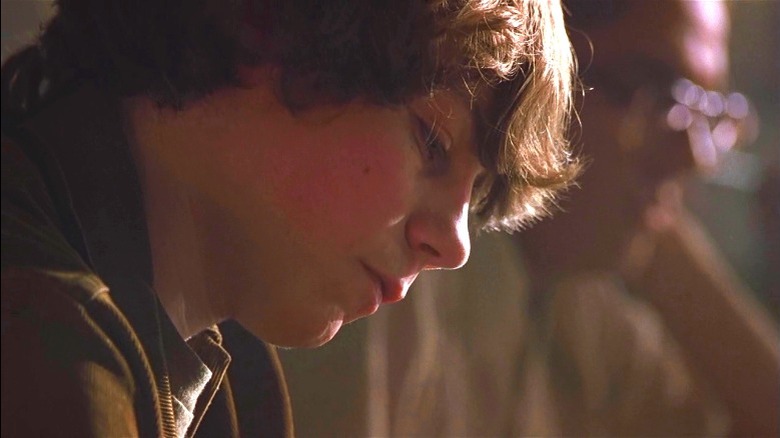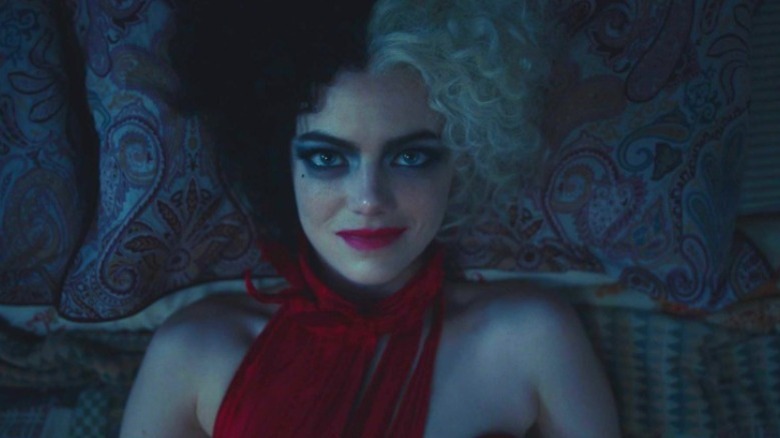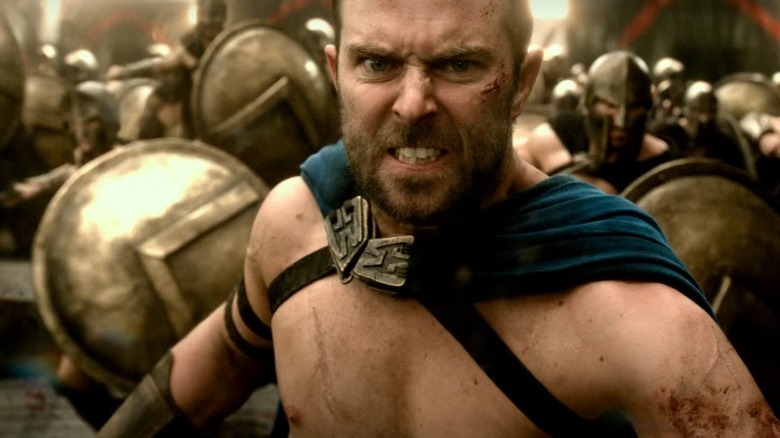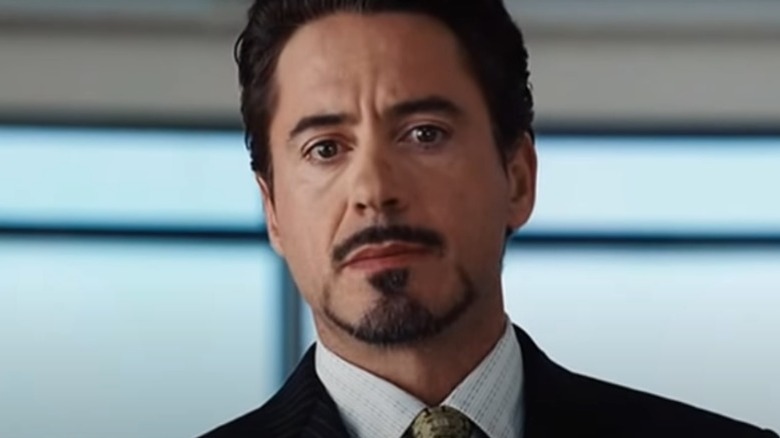Movies That Used Black Sabbath Songs The Best
Black Sabbath is a legendary band. As noted by Rolling Stone, not only are they responsible for some of the hardest-rocking songs of all time, they're also widely considered to be one of the foundational bands in the heavy metal genre—and possibly the most important. While bands like Led Zeppelin and Deep Purple were crucial to the development of heavy guitar-rock, Black Sabbath was the band that took all those ingredients and fused them into an exciting new shape.
They were also a dangerous band. While it might seem a little silly in the modern day, back in 1970 Black Sabbath was a mysterious group with overt references to Satanism and the occult. For years they endured rumors that they were involved in dark forces and were something more than just a rock band. But they were just a rock band—but an incredibly talented rock band. Ozzy Osbourne is widely regarded as one of the greatest rock singers of all time (per Guitar World), lead guitarist Tony Iommi is regarded as one of the greatest guitarists of all time (per Rolling Stone), bassist Geezer Butler is considered one of the greatest bassists in rock history (per Ultimate Guitar)—you get the idea.
In other words, those old Black Sabbaths songs slammed. So it's not surprising that they're a popular choice for movie soundtracks. When used properly, a classic Sabbath track can make a scene legendary. Here are the movies that used Black Sabbath songs the best.
School of Rock: 'Iron Man'
"School of Rock" is one of those films that has grown more beloved and appreciated as time goes on. As noted by ViacomCBS, the film was modestly budgeted and marketed, and wasn't a smash, but was a reasonable success.
Today, the film is regarded as a classic—Complex called it "the best music movie of the 21st century." Some of that success comes from the verisimilitude—writer Mike White was inspired by his time living next door to star Jack Black—and part of it comes from the film's warm, beating heart. But a huge reason the film is so beloved is the music—this is a movie that is unabashedly about how great rock music is and how it can transform your life. And Black Sabbath has a brief but crucial role to play in that.
The band's all-time classic "Iron Man" pops up in the sequence when Black's character, Dewey, challenges one of his students, Zack, to play electric guitar. The first riff Dewey plays for Zack? "Iron Man." It's a powerful moment because everyone in the audience, regardless of their level of affection for hard rock, knows that riff. It instantly grounds the moment—and when Zack immediately plays the riff back, he's living the dream of anyone who ever picked up a guitar and discovered that the simplest-sounding riffs in the world are hella difficult to actually play.
Dazed and Confused: 'Paranoid'
Richard Linklater's "Dazed and Confused" wasn't a major release in 1993. The director wanted a realistic, natural feel to his story of teenagers doing shenanigans in 1976 Texas, and part of that involved assembling a soundtrack of rock music accurate to the month—as The Ringer notes, he rejected a Thin Lizzy song because he thought it was released two months after the film's story ends. He also had to fight the studio to get the original songs instead of having a current band re-record them in the service of synergy.
As noted by Far Out Magazine, Linklater uses music to set a tone of nostalgia in the film, and one of the best uses is Black Sabbath's "Paranoid." The film doesn't have a terribly complex plot, but a big part of the story involves a group of seniors at the local high school hazing incoming freshmen by chasing them down and paddling them. The younger kids are understandably anxious about this tradition—so Linklater's use of the song while a group of older boys creeps up behind a trio of freshmen is genius. The song's opening riff (which GuitarPlayer ranks as one of the greatest of all time) plays almost subliminally in the background as the car approaches. When the freshmen realize what's happening, the song erupts into full volume on the soundtrack. It's a perfect match of the mood on the screen and the music on the soundtrack.
Wayne's World: 'Time Machine'
"Wayne's World" was a huge hit in 1992. As noted by The Ringer, it was born out of an iconic "Saturday Night Live" sketch in which Mike Myers and Dana Carvey played suburban slackers hosting their own low-rent public access cable show. the film is a shaggy dog of interconnected skits, dopey humor—and an unapologetically heavy metal soundtrack.
Because Wayne and Garth are so deeply, nerdily into heavy metal, it's no surprise that Black Sabbath makes an appearance on the soundtrack. But it's how the song is used that makes it so memorable. The scene starts off with Wayne driving the infamous "Mirthmobile" (as reported by CarThrottle, a 1976 AMC Pacer) with Sabbath's "Time Machine" basting on the stereo. The beginning of the scene perfectly captures the simple joys of cruising around with a favorite song blasting.
Then, a police officer on a motorcycle pulls Wayne over. As noted by Planet Radio, when he storms up to the window, it turns out to be the T-1000 from "Terminator 2: Judgment Day" (played by Robert Patrick). Considering the "Terminator" films are about time-traveling robots, that makes the choice of music absolutely perfect. Even better, Far Out Magazine reports that Sabbath recorded a special version of the song specifically for the film, featuring a different version of the guitar solo.
The Hangover Part III: 'N.I.B.'
"The Hangover" film series was in some ways an exercise in diminishing returns. By the time we're dealing with the third lost weekend involving a bunch of goofs played by Bradley Cooper, Ed Helms, Justin Bartha, and Zach Galifianakis there wasn't much surprise left in the premise. Far Out Magazine notes that the "film is a disaster and far off the pleasant experience of the first movie."
With the exception of Leslie Chow. As played by Ken Jeong, Chow is a reliable chaos machine in all three "Hangover" films, a Chinese gangster who parties at an insane level. And so it's no surprise that one of the best moments in "The Hangover Part III" involved Leslie Chow—and Black Sabbath.
The scene is set at Chow's penthouse. Cooper and Galifianakis have arrived to track down the gangster and find themselves in a strobe-lit nightmare of a party. As TV Overmind notes, the song choice for this scene—"N.I.B." by Sabbath—is a perfect match to the drugged-out insanity of Leslie Chow's life. The song's aggressive and ominous riff combined with the flashes of craziness creates a sense of dreamy horror, as if you've just stepped into a crazy alternate world. And letting the song just play over the entire scene adds to the sense of otherworldly craziness.
Kong: Skull Island: 'Paranoid'
Crafting a terrific action sequence requires a few fundamental ingredients: Visual flair, sharp editing, surprise, and a kick-butt song. The helicopter scene in "Kong: Skull Island" is a masterful example of how great the movies get when you hit all of those targets.
A riff on the iconic "Ride of the Valkyries" scene in "Apocalypse Now," the scene begins when a soldier flicks on the reel-to-reel tape recorder mounted in their helicopter. The unmistakable opening riff of "Paranoid" fills the air as a fleet of military helicopters deploys. As noted by Kerrang!, the scene perfectly captures the arrogance and wastefulness of the American military machine, and the song is ideally paired with the violence of carpet-bombing the island without any consideration for the living creatures that are killed as a result.
The editing is masterful, too. The scene establishes that the soldiers are supreme—nothing can stop them from delivering their bombs and taking their measurements. They grin and laugh as they exert total power over their environment—as TV Overmind puts it, they're enjoying "being the biggest, baddest, most hostile thing in the jungle," which makes "Paranoid" an inspired choice. And then, suddenly, an enormous tree smashed into one of the helicopters, sending it spinning in flames to the ground—and the soundtrack goes silent to let us know that the true apex predator of the island has arrived.
Heavy Metal: 'The Mob Rules'
1981's "Heavy Metal" was a strange film. Inspired by and based on the science fiction and fantasy comic Heavy Metal (itself originally a licensed translation of a French magazine called Metal Hurlant), the film combined rotoscoped animation, a hard-R rating, and hard rock music to deliver a trippy, erotic, and violent experience. As the Austin Chronicle notes, the film featured five distinct stories from underground artists—and a soundtrack of heavy, heavy music. Although it had mixed success upon release, the film's style is considered influential today.
As noted by Loudwire, Black Sabbath survived the departure of their legendary original singer, Ozzy Osbourne, in 1980, hiring the equally legendary Ronnie James Dio as their new frontman. The title track of their second album with Dio, "The Mob Rules," appeared in "Heavy Metal" in the ninth sequence, "Taarna." In this sequence, a crowd of people mutates into violent monsters when they encounter an alien substance and go on an ultra-violent rampage.
As noted by Red Mango Reviews, "Taarna" and the heroic, hyper-sexualized last of the Taarakians are probably the most recognizable and iconic visuals in the film, and "The Mob Rules" is used perfectly. It fits the story, the tone, and the visuals—the sequence could be a music video for the song instead of a scene from a movie.
Dogtown And Z-Boys: 'Into the Void'
"Into the Void" is a deep cut—if you're only a casual fan of Black Sabbath you might not be aware of it (but Rolling Stone reports that it was voted the #4 best deep Sabbath cut of all time). As Kerrang! notes, tuning down three-and-a-half steps gives the song a darkness and heaviness that really redefined the sound of heavy metal.
This might not seem like an ideal match for "Dogtown And Z-Boys," a documentary about skateboarders—but it is. As noted by Screen Rant, the film follows a group of surfers who resuscitated skateboarding culture in the 1970s by introducing surfing techniques and moves. The song's lyrics are perfect for a bunch of kids addicted to speed and stunts: "Rocket engines burning fuel so fast / Up into the night sky they blast."
In fact, Far Out Magazine calls the placement of "Into the Void" the "best moment in the film." Kerrang! explains that the song is a sci-fi story about astronauts fleeing a dying Earth, and the doomed tone and constantly shifting rhythms and speed of the song make it ideal for the fast, dangerous world of skateboarding.
This is The End: 'War Pigs'
Normally a song like "War Pigs" is used to soundtrack scenes that are a bit grim and violent. But that's what makes its use in the 2013 Seth Rogen and Evan Goldberg comedy "This Is the End" so brilliant. As noted by Roger Ebert, the film straddles the line between fantasy and reality—on the one hand, the Rapture has arrived and demons are literally stalking those left behind on Earth. On the other hand, the film is populated by celebrities playing wacky versions of themselves that lends it a sense of verisimilitude.
According to Screen Rant, the scene where "War Pigs" arrives depicts the group of spoiled celebrities trapped in James Franco's house while the world ends outside as they secure the home against invaders. In a more serious film, this sort of scene would be a tightly edited montage of dangerous, capable people hardening a house against demonic invasion. In "This Is the End," it's Seth Rogen putting a single strip of duct tape over an enormous crack in the wall in a very self-satisfied way. The contrast between the ludicrous attempts by these spoiled actors to fortify the house and the dark, gritty power of "War Pigs" is just inherently hilarious, and transforms the scene from mildly funny to hilarious.
Almost Famous: 'Sweet Leaf'
Cameron Crowe is a filmmaker who believes music is crucial to any story. His semi-autobiographical film "Almost Famous" tells the story of a smart, talented high school kid named William who finds himself on tour with an up-and-coming rock band in order to write a feature for Rolling Stone—whose editor is unaware of William's true age.
The film is crammed full of classic rock goodness, and every needle drop is purposeful and designed to add dimension to the scene. So it's no mistake that, as noted by Screen Rant, Black Sabbath's song "Sweet Leaf" (which Far Out Magazine reports is not-so-secretly about celebrating marijuana) is played during the scene when the lead singer of Stillwater invites William to L.A. to follow the band and chronicle their tour (in the film, Stillwater just opened for Black Sabbath, so the tune also serves to ground the viewer in the time and place).
This is an innocent kid heading off to enter a world of sex, drugs, and rock and roll—and whose mother is very worried he'll soon know all about "sweet leaf"—so having the song playing softly in the background is a nice, subtle touch. It's one of the most thoughtful uses of a Black Sabbath song in a film.
Cruella: 'The Wizard'
"The Wizard" by Black Sabbath is a weird song. It's one of a very few heavy metal songs that opens with a harmonica riff. It's also explicitly about the character Gandalf from "The Lord of the Rings," according to Metal Sludge. And while the song is an absolutely banger, it's strange to hear a Black Sabbath song in a Disney film.
It's not there for long—Mashable calls it a "snippet"—and it's part of what Collider describes as a "fusion needle drop" where two songs are blended together (the second song here is "Sympathy for the Devil" by The Rolling Stones). And it's one of many, many songs—there are more than 30 songs dropped during the course of the film, which means there's a new song hitting your ears every four minutes or so. As noted by FreshFiction.tv this was a deliberate choice by director Craig Gillespie, who "designed the movie knowing we're gonna have music."
What's key here is the moment in the story—this is when the character of Estella fully transforms into the character of Cruella. As Cruella changes the sign reading "Hellman Hall" so that it reads "Hell Hall," "The Wizard" is ideal accompaniment as it's about a mysterious and dangerous figure who is "Casting his shadow, weaving his spell."
300: Rise of an Empire: 'War Pigs'
It's ironic that "War Pigs" by Black Sabbath is so often paired with violence and bloody battles on the screen, because Geezer Butler wrote it with the idea that war was the ultimate evil, according to Noisecreep. But there's no denying that the legendarily huge riffs in this song combined with one of the best early Ozzy Osbourne vocal performances make this a song ideal for psyching up an audience.
And as noted by Far Out Magazine, that's exactly the effect the song gives in the end credits of "300: Rise of an Empire," calling it "the perfect rallying cry for battle." When an exciting movie ends, there's a rush of excitement, and Osbourne's powerful vocals on this classic track sends the crowd home on a high note. What really makes the song work so well is the fact that it's not the original version—it's a remix. The original is one of the best hard rock songs ever recorded, but the remix ties it explicitly to the universe of the film. GQ reports that composer Tom Holkenborg, known as Junkie XL, created the song for the soundtrack by taking Osbourne's vocals and building a "whole new track around it."
The result is a nearly perfect fusion of Black Sabbath's gritty take on the horrors of war and the film's heightened visuals.
Iron Man: 'Iron Man'
When you make a film about Iron Man and call that film "Iron Man," you know your audience is just sitting there waiting for the song to show up (although Screen Rant reports that studio executives didn't want to pay to use the song, which seems ... crazy). The genius of the song's appearance in 2008's "Iron Man" is that it booms onto the soundtrack just as Tony Stark (Robert Downey, Jr.) announces to the world "I am Iron Man" (an improvised moment, according to IndieWire, and a brilliant one). As noted by TV Overmind, the appearance of the song implies that Stark/Iron Man is finally accepting his new identity, and is ready to step up and be a hero.
This is also genius because of the delayed gratification. There are plenty of moments during the film when a less imaginative (or patient) filmmaker could have needle-dropped the song, but director Jon Favreau held off and waited for the absolutely perfect moment right at the end. By that point, the audience is primed for a fist-pumping moment, and Stark claiming his identity is it. The song is transformed from a dark sci-fi story to a celebration in an instant.
